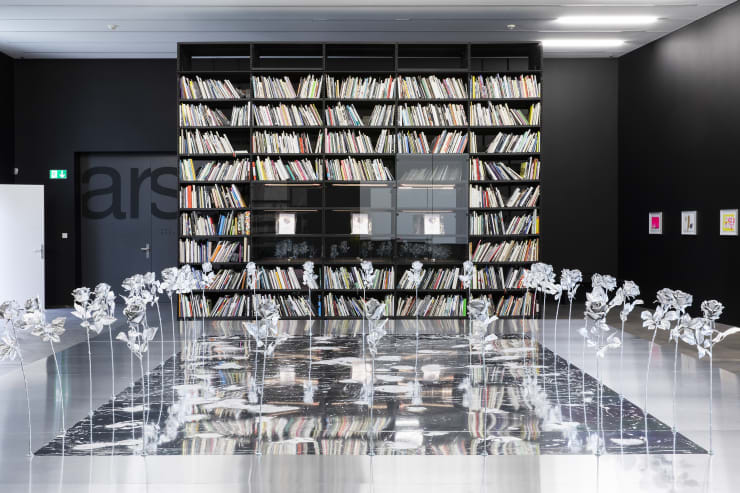Underworld Classic | Luma Westbau: Sitara Abuzar Ghaznawi
In her first institutional solo exhibition, Sitara Abuzar Ghaznawi deals with the often thematized tension between art and the public sphere by means of a large-scale intervention in Heimo Zobernig's schwarzescafé, which significantly determines the exhibition space. Zobernig's permanent, multifunctionally conceived work invokes the coffeehouse (especially in its Austrian variant in Vienna at the turn of the century) as an exemplary site of bourgeois public sphere in modernity and translates it into the present, where the café has become one of the central topoi of an economy oriented towards exchange, communication, and the circulation of ideas, as well as the site of precarious labor par excellence. The use of the color black, which dominates the work, can thus be interpreted not only as a formalist borrowing from the history of monochrome and minimal art, but also as an allusion to its much-lamented decay.
Ghaznawi's intervention consists of replacing Zobernig's tables and seating furniture with a large, centrally placed platform. A line of roses running along all sides delimits the outer edge, which also invites visitors to sit, from a large reflective surface in the center, which is reminiscent of a water surface and contributes to the overall impression of a fountain, as is often encountered as an urban planning instrument in public squares. The work is conceived as a public sculpture that will be erected in the backyard of the Löwenbräu site following the exhibition. For the duration of the exhibition, however, it assumes a function that is usually understood in the opposite way: it serves as an exhibition bench for viewing Ghaznawi's hybrid collage drawings attached to the walls. An element of classical exhibition architecture, the bench functions as a paradigmatic model of an aesthetic oriented towards the contemplation of autonomous works of art, which is intended to guarantee the ideal of disembodied seeing by making the visual experience as effortless as possible. The play between hetero- and autonomy inherent in the initially seemingly polar dual function of sculpture is also found in the small-format drawings. Abstract compositions are expressed by means of various materials such as nail polish, adhesive tape, and pieces of jewelry attached to photographic paper.
The question of the role of art in public space and its instrumentalization in the context of urban development programs, as well as the meaning of the word construction "public art," was addressed in detail by the U.S. art historian Rosalyn Deutsche in her collection of essays Evictions. Art and Spatial Politics.¹ In it, she reflects on its euphoric appropriation by those responsible for administration and urban planning and the rhetoric that accompanies it, which ascribes special democratic-egalitarian qualities to it and equates the public sphere with consensus and harmony. Drawing on radical democratic theories that define democracy and public space in terms of the negation of any positive, substantive basis of the social, she argues in their place for a fundamentally antagonistic² and conflictual understanding of the public sphere. Tracing a geneaology of various influential conceptions of the public sphere, her critique is directed primarily against what she calls "agoraphobic" concepts characterized by the notion of a mournful decline of the public sphere. As an alternative, she takes up the description of this public sphere as phantom proposed by various authors. Deutsche writes:
"traditional public space is a phantom less because it was never fully realized than because the ideal of social coherence, for which the term public has always stood, is itself irremediably deceptive and, moreover, oppressive. The ideal of a non coercive consensus reached through reason is an illusion maintained by repressing differences and particularities."³.
The traditional conception of public space presupposes a strict separation between a universalistic public sphere and a private sphere determined by particular interests. Deutsche takes up Thomas Keenan's proposal to conceive of the structure of the public sphere as analogous to language. Similar to psychoanalytic theories of subject constitution via entry into language, this allows us to overcome the strict opposition between public and private spheres. The public sphere is thus structurally dislocated and can therefore be characterized neither by its loss nor by the urge to restore it. Rather, it is characterized by the resistance of absolute presence. "It emerges when society is insti- tuted as society with no basis, a society as Lefort writes, 'without a body ... a society which undermines the representation of an organic totality,'" writes Deutsche.(4) Its presence without substantial basis and positivity makes it a powerful instrument for radical democratic politics.
Ghaznawi's work can be read as a reminder. However, the roses lining it do not mourn a lost public sphere, which at best needs to be regained. In the reflective surface, the phantom of a democratic public sphere appears and its melancholy, which also characterizes most of Ghaznawi's previous works as an affective mood, rather moves her practice close to a feminist-motivated critique of what Sara Ahmed has called the "promise of happiness" and described figuratively in the figures of the "feminist buzzkill," the "unhappy queer," and the "melancholic migrant. (5) All figures that would have no place in descriptions of a vanished, uniformly imagined public sphere.
Rosalyn Deutsche, Art and Spatial Practice (Cambridge, MA and London: The MIT Press, 1998).
Following Ernesto Laclau and Chantal Mouffe, she conceptualizes antagonism as a "relationship between a social identity and a 'constitutive outside' that blocks its completion." "Agoraphobia," in Ibid, pp. 269- 327, here p. 274.
Deutsche here paraphrases a reflection by Bruce Robbins. Ibid, p. 320
Ibid, p. 324.
Sara Ahmed, The Promise of Happiness. (Durham, NC and London: Duke University Press, 2010).
Venue: Luma Westbau, Zurich
For further information, please visit the website:







